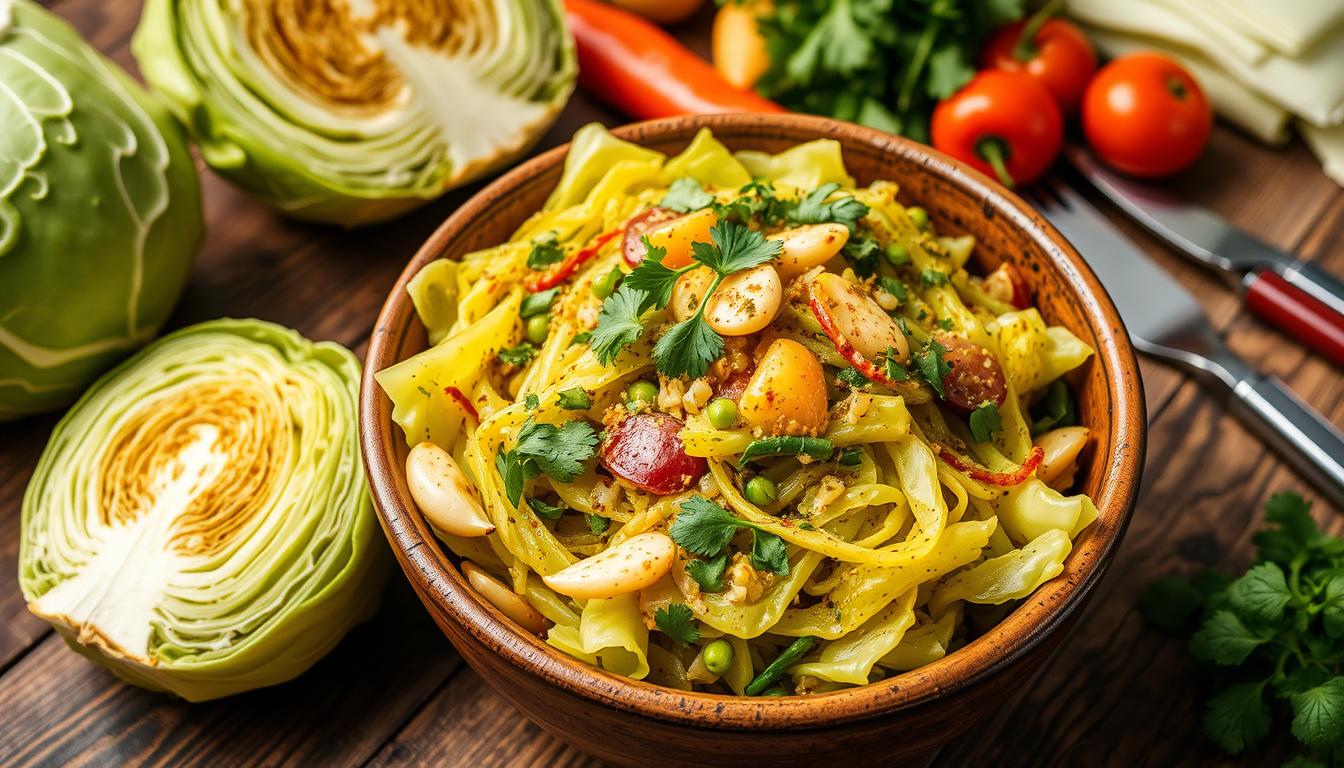Are you tired of the same old dinner options? Our quick and easy homemade cabbage recipe is here to change that. It’s not only delicious but also good for you and won’t break the bank. Learn how to turn this humble veggie into a tasty dish that everyone will love.

Key Takeaways
- Cabbage is a versatile and budget-friendly vegetable that can be transformed into a delicious dinner option.
- This recipe offers a simple and fuss-free way to prepare cabbage, making it perfect for busy weeknights.
- Cabbage is packed with essential nutrients and can be a healthy addition to your meal planning.
- Learn how to avoid common cooking mistakes and maximize the flavor of your homemade cabbage dish.
- Discover easy variations and pairing ideas to make your cabbage dinner even more exciting.
Why Cabbage is a Perfect Choice for Your Dinner Table
Cabbage is a great pick for a tasty and healthy dinner. It’s packed with nutrients and is easy on your wallet. This makes it a top choice for family meals.
Nutritional Benefits of Cabbage
Cabbage is full of vitamins and minerals. It has vitamins C, K, and B6, plus fiber, folate, and manganese. It also has antioxidants that boost health. Plus, it’s low in calories, perfect for healthy recipes and cabbage dishes.
Budget-Friendly Meal Planning with Cabbage
Cabbage is very affordable. It’s cheaper than many veggies, helping you save money. This is great for families wanting to eat well without spending a lot.
| Nutritional Comparison: Cabbage vs. Other Vegetables | Cabbage | Broccoli | Spinach |
|---|---|---|---|
| Vitamin C (per 100g) | 51 mg | 89 mg | 28 mg |
| Fiber (per 100g) | 2.5 g | 2.4 g | 2.2 g |
| Calories (per 100g) | 25 | 34 | 23 |
Cabbage is as good as other veggies in terms of nutrition. It’s a smart choice for healthy recipes and cabbage dishes. You get tasty, healthy meals without spending a lot.
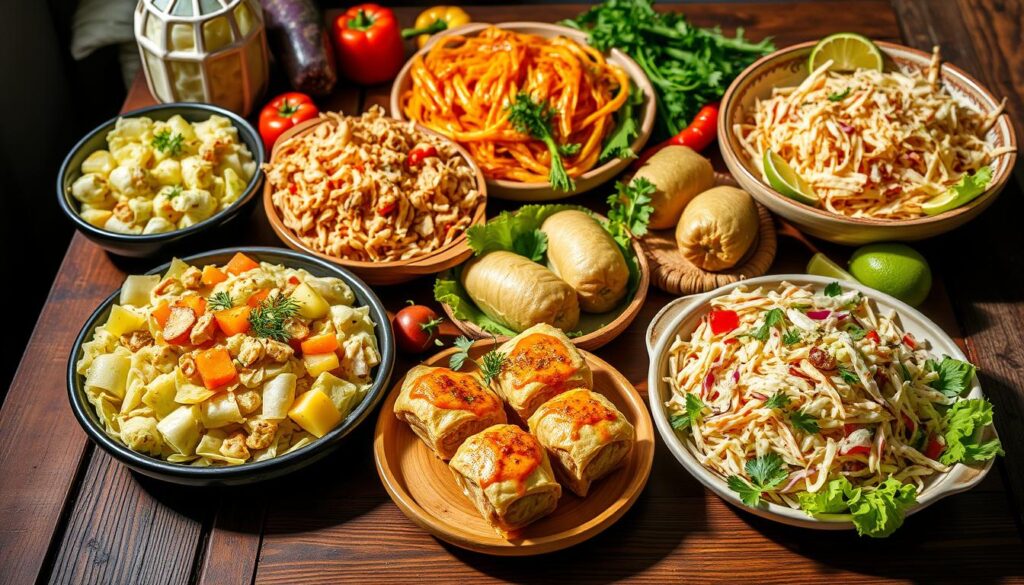
Essential Ingredients for the Perfect Cabbage Recipe
Making a tasty cabbage dish starts with the right ingredients. Whether you’re a pro chef or a new cook, the right stuff makes a big difference. Let’s look at the key ingredients for a cabbage recipe that will impress everyone.
Staple Ingredients
- Fresh green or red cabbage, finely shredded or chopped
- Olive oil or butter for sautéing
- Onions, diced or thinly sliced
- Garlic cloves, minced or crushed
- Salt and freshly ground black pepper to taste
Optional Add-Ins for Extra Flavor
- Bacon bits or crumbled cooked bacon for a smoky, savory twist
- Fresh herbs like thyme, rosemary, or parsley to enhance the aroma and taste
- Spices such as caraway seeds, cumin, or paprika to elevate the dish
- Vinegar (apple cider, balsamic, or white wine) for a touch of acidity
- Broth or stock (vegetable, chicken, or beef) to create a more robust, flavorful base
Cabbage recipes are super versatile. Don’t be afraid to mix and match ingredients to find your favorite. It’s a great way to enjoy this healthy and affordable veggie.
| Ingredient | Purpose | Quantity |
|---|---|---|
| Cabbage | Main vegetable | 1 head, finely shredded or chopped |
| Olive oil or butter | Sautéing | 2-3 tablespoons |
| Onions | Flavor base | 1 medium, diced or thinly sliced |
| Garlic | Flavor enhancement | 2-3 cloves, minced or crushed |
| Salt and pepper | Seasoning | To taste |
With these ingredients, you’re ready to make a delicious cabbage dish. It will soon become a favorite in your kitchen.
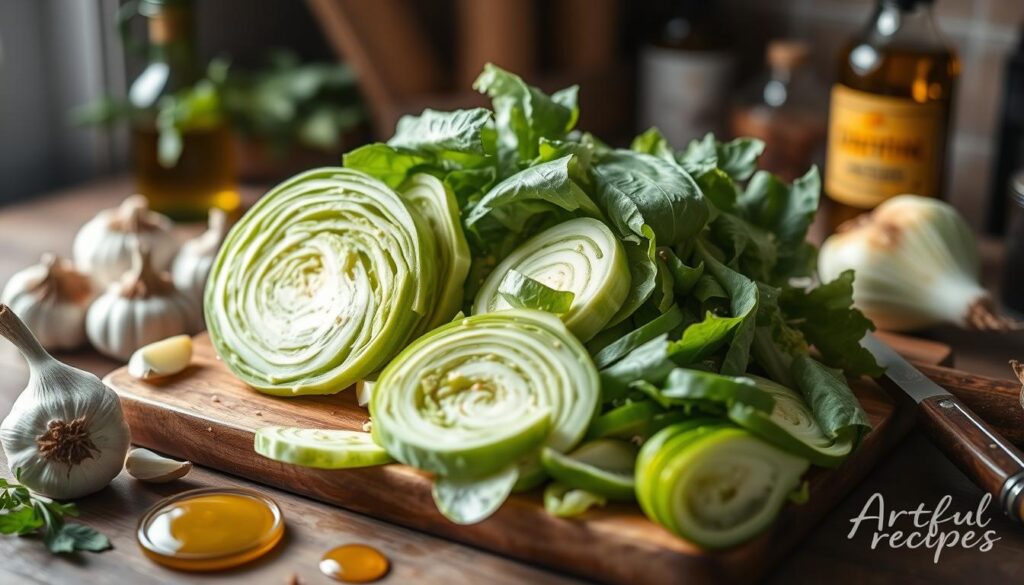
Kitchen Tools and Equipment You’ll Need
To make tasty cabbage dishes at home, you need the right tools. From simple cutting boards to special gadgets, the right tools make cooking easier and fun. Let’s look at the key items you’ll need to make easy cabbage meals.
Proper Cutting and Chopping Tools
For cabbage preparation, the right knives are key. A sharp chef’s knife or a serrated knife makes cutting easy. You’ll also need a strong cutting board, like wood or plastic, for chopping.
For even cuts, think about a mandoline slicer or a food processor with a slicer attachment. These tools help you get precise cuts.
Optional Kitchen Gadgets for Easier Preparation
- Vegetable peeler: Useful for removing tough outer leaves or stems from cabbage heads.
- Cabbage corer: Designed specifically to remove the core from a cabbage, making it easier to slice and shred.
- Salad spinner: Helps remove excess moisture from shredded or chopped cabbage, ensuring a crisper texture in your dishes.
- Food processor: Equipped with various blades, a food processor can quickly shred, slice, or chop cabbage for easy cabbage meals.
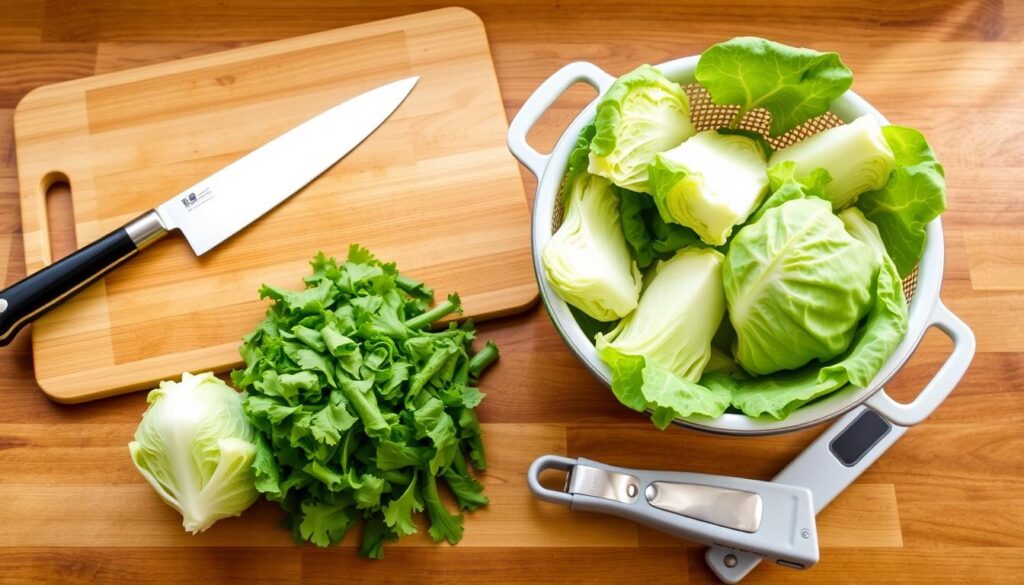
While these gadgets can speed up cabbage preparation, they’re not must-haves. With basic tools, you can still whip up tasty cabbage dishes at home.
Step-by-Step Preparation Guide
Getting your cabbage ready for dinner is easy. Just follow these simple steps to prepare your cabbage:
- Begin by rinsing the cabbage under cool water. Then, dry it with a clean towel.
- Cut the cabbage in half and slice each half into thin strips. Make them about 1/4 to 1/2 inch thick. This helps it cook evenly.
- If you want smaller pieces, chop the strips into bite-sized chunks.
- For cabbage wedges or quarters, cut the cabbage in half. Then, slice each half into 2-3 wedges, depending on the head size.
Proper preparation is key to unlocking your cabbage’s full flavor and texture. By following these steps, your cabbage recipe will always be perfect.
| Cutting Method | Recommended Use |
|---|---|
| Thin Strips or Shreds | Stir-fries, slaws, and quick-cooking recipes |
| Bite-sized Chunks | Soups, stews, and braises |
| Wedges | Roasted or grilled cabbage dishes |
With these cabbage preparation techniques, you’ll make delicious, perfectly cooked cabbage every time.
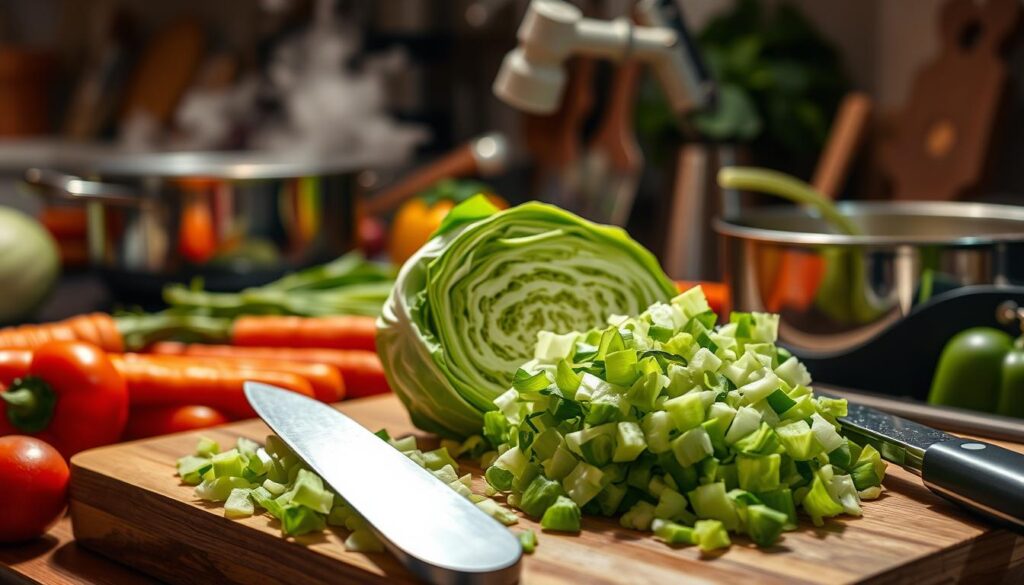
Mastering the Basic Cabbage Recipe
Cooking cabbage is easy and rewarding. By learning the basics, you can make tasty cabbage dishes. These dishes are not only healthy but also very satisfying. Let’s explore the key tips and tricks for making your cabbage recipes perfect.
Seasoning Tips and Tricks
Cabbage goes well with many seasonings and spices. To enhance its flavors, try these seasoning tips:
- Begin with a mix of salt, pepper, and garlic powder for a great base.
- Try herbs like thyme, rosemary, or oregano for more depth.
- Add a bit of vinegar or lemon juice to balance its sweetness.
- Use a pinch of crushed red pepper flakes for a hint of heat.
Cooking Temperature Guidelines
Getting the right temperature is crucial for cooking cabbage. Here are some guidelines to cook cabbage perfectly:
- For sautéed or stir-fried cabbage, use medium-high heat (350°F to 400°F) for a crisp texture.
- For braising or slow-cooking, keep the heat lower (300°F to 325°F) to make it tender and flavorful.
- Roasting cabbage works best at a higher temperature (400°F to 425°F) for caramelized edges.
Mastering seasoning and temperature will help you make delicious cabbage dishes. These dishes will surely impress your loved ones.
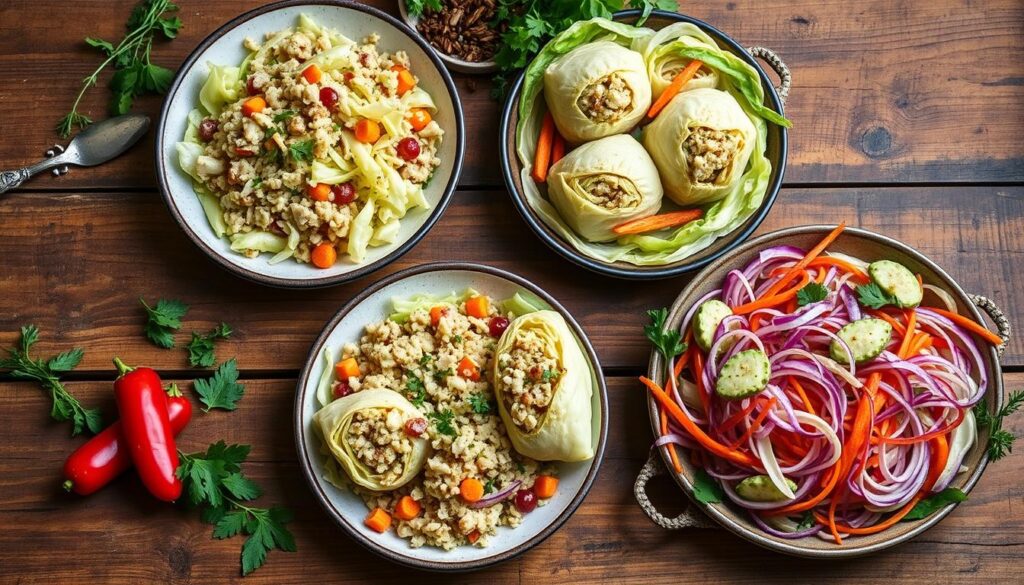
Delicious Variations of Traditional Cabbage Dishes
Cabbage is a versatile vegetable that can be transformed into many delicious dishes. It’s not just for coleslaw and sauerkraut. There are endless ways to make your taste buds happy. Try these tasty cabbage dish variations to make your meals more exciting.
Vibrant Coleslaw Creations
Coleslaw is a favorite, but why not try something new? Mix in shredded carrots, red cabbage, and fresh herbs for a stunning slaw. Top it with a tangy vinaigrette or creamy dressing for a refreshing side.
Savory Sauerkraut Sensations
Sauerkraut is a classic with a tangy flavor. Spice it up with garlic or bacon for a richer taste. Serve it with grilled sausages, pork chops, or rye bread for a cozy meal.
Innovative Cabbage Rolls and Stuffed Cabbage
Cabbage rolls, or golabki, are a Polish delight. Fill tender cabbage leaves with meat, rice, and spices. Bake or simmer in tomato sauce for a show-stopping dish.
| Cabbage Dish | Flavor Profile | Serving Suggestions |
|---|---|---|
| Coleslaw | Crunchy, tangy, and refreshing | Barbecue dishes, sandwiches, or as a side salad |
| Sauerkraut | Tangy, sour, and savory | Grilled sausages, pork dishes, or as a topping for rye bread |
| Cabbage Rolls | Hearty, stuffed, and comforting | Served with mashed potatoes or a side of roasted vegetables |
Discover the versatility of cabbage and try these tasty variations. From vibrant coleslaws to savory sauerkraut and stuffed cabbage rolls, there’s always something new to enjoy!
Pairing Your Cabbage Dish with Other Foods
Finding the right foods to go with your cabbage dish is key to a great meal. Whether it’s a classic coleslaw or a hearty braised cabbage, there are many sides and proteins that can make your meal complete. These can turn your cabbage dish into a full and nourishing meal.
Complementary Side Dishes
Cabbage goes well with many side dishes. These can add texture, flavor, and nutrients to your meal. Try serving your cabbage with:
- Roasted potatoes or sweet potatoes for a starchy and satisfying complement
- Sautéed mushrooms or onions to add depth and savory notes
- Fresh, crisp salads to balance the heartiness of the cabbage
- Steamed or roasted vegetables like carrots, broccoli, or Brussels sprouts for a nutrient-dense side
Protein Options for a Complete Meal
To make your cabbage dish a main course, pair it with a lean protein. Here are some tasty options:
- Grilled or baked chicken breasts for a classic protein-packed pairing
- Seared pork chops or tenderloin for a flavorful and satisfying combination
- Baked or pan-seared fish, such as salmon or tilapia, for a healthy and lean option
- Hearty plant-based proteins like tofu, tempeh, or lentils for a vegetarian or vegan-friendly meal
By choosing the right sides and proteins, you can make a balanced and healthy recipes meal. This will highlight the versatility and deliciousness of your homemade cabbage side dishes.
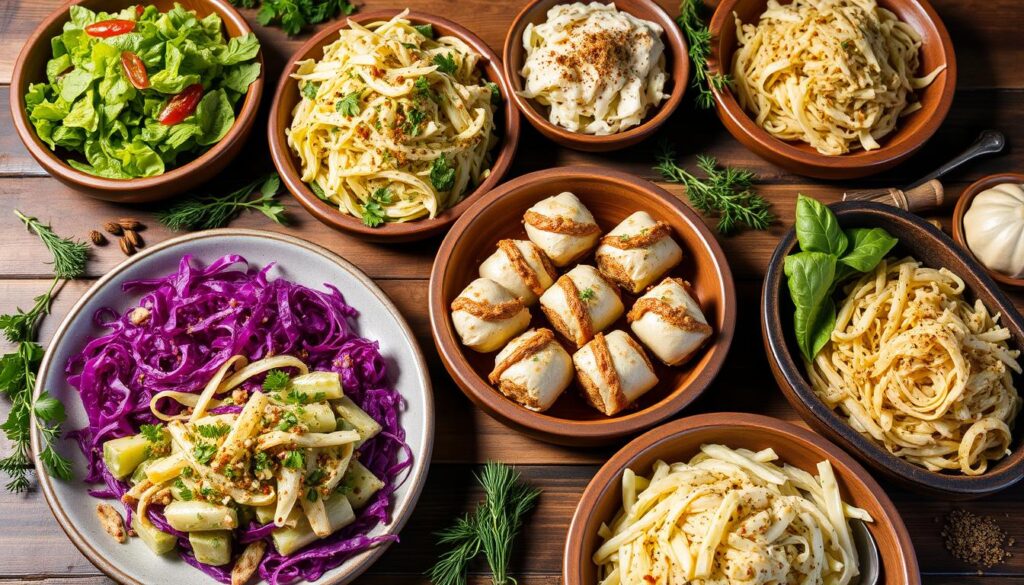
Storage Tips and Leftover Management
Keeping cabbage fresh is important, whether it’s raw or cooked. A few simple steps can help keep your cabbage dishes fresh longer. This way, you can reduce food waste too.
Storing Raw Cabbage
Start by removing any bad or wilted leaves from the cabbage. Then, put the whole head in a bag with holes or wrap it in a damp paper towel. Keep it in the fridge’s crisper drawer. This keeps it crisp for up to a week.
Storing Cooked Cabbage
Cooked cabbage can stay in the fridge for 3-4 days in an airtight container. For longer, you can freeze it for up to 3 months. Just cool the cabbage and put it in a freezer-safe bag or container, leaving some space for it to expand.
Repurposing Leftover Cabbage
Don’t throw away leftover cabbage! Here are some fun ways to use it:
- Chop it and add to soups, stews, or fried rice.
- Sauté it with eggs for a tasty breakfast.
- Mix it into tuna, chicken, or egg salad for a tasty sandwich.
- Roast it with other veggies for a healthy side dish.
- Blend it into a creamy cabbage slaw or salad.
| Storage Method | Raw Cabbage | Cooked Cabbage |
|---|---|---|
| Refrigerator | Up to 1 week | 3-4 days |
| Freezer | N/A | Up to 3 months |
By using these tips, you can enjoy tasty cabbage preparation and easy cabbage meals for days.
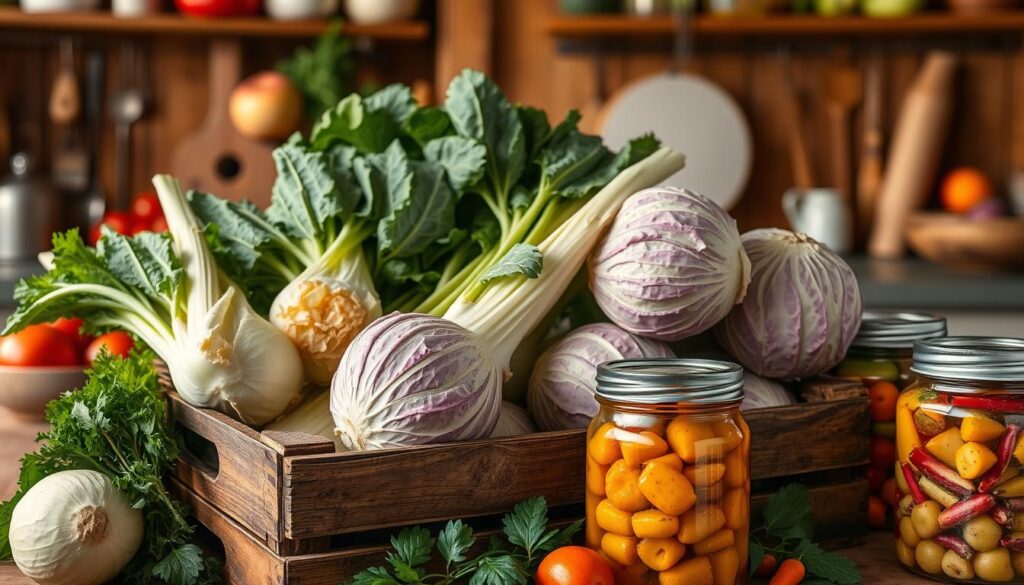
Common Mistakes to Avoid When Cooking Cabbage
Cooking cabbage can be a fun and tasty experience. But, it’s easy to make mistakes. Knowing the common errors and how to avoid them is key to a perfect cabbage recipe.
Troubleshooting Cooking Issues
One big mistake is overcooking cabbage. This makes it mushy and unappealing. To avoid this, watch the cooking time closely. Check the cabbage often to get it just right.
Another common problem is not seasoning enough. Cabbage can taste bland by itself. So, season it well with salt, pepper, and spices. Taste it as you go and adjust the seasoning.
- Avoid overcooking cabbage to prevent a mushy texture.
- Ensure proper seasoning to enhance the natural flavors of cabbage.
- Consider adding aromatics like garlic, onions, or herbs to boost the overall taste.
- Adjust cooking time and temperature based on the specific variety of cabbage you’re using.
By avoiding these common mistakes, you can make delicious cabbage dishes. These dishes will surely impress your family and friends.
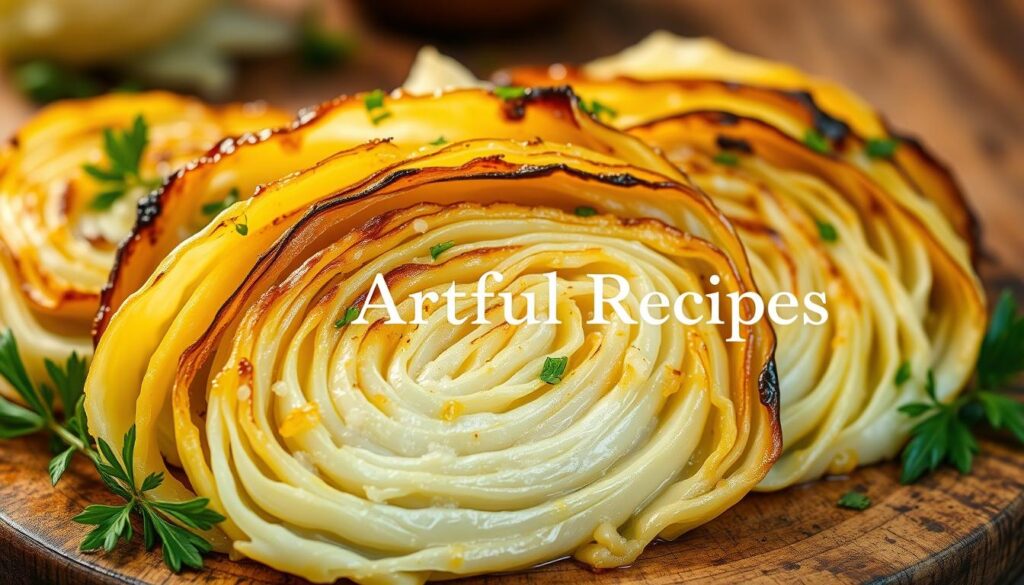
Health Benefits and Dietary Considerations
Adding cabbage to your meals can boost your health. It’s full of vitamins C, K, and B6, plus fiber, folate, and antioxidants. Eating cabbage helps prevent diseases and keeps you feeling good.
Promoting Heart Health
Cabbage has sulforaphane and indole-3-carbinol, which lower cholesterol and heart disease risk. Its fiber helps keep blood pressure in check and supports heart health.
Weight Management
Cabbage is low in calories but high in fiber. It helps you feel full, which can lead to eating fewer calories and losing weight.
Dietary Considerations
Most people can eat cabbage without issues, but some should be careful. Those with thyroid problems might want to avoid raw cabbage because of goitrogens.
Adding cabbage to your meals can improve your health. Knowing its nutritional value and any dietary concerns helps you use it wisely in your diet.
Time-Saving Tips for Busy Cooks
Finding time to cook healthy meals can be tough, even for experienced cooks. But, with a few smart tricks, you can add easy cabbage meals to your menu without losing time.
Start by chopping and slicing cabbage ahead of time. Spend a bit of time on the weekend to prep your cabbage. Then, store it in a container in the fridge. This saves you time during the week.
- Invest in a quality food processor or mandoline slicer to make quick work of cabbage preparation.
- Chop or shred extra cabbage and freeze it in portion-sized bags for easy access later.
- Utilize the convenience of pre-shredded or coleslaw mix cabbage from the grocery store to save time on busy nights.
Plan your meals to include cabbage. Choose dishes that cook in one pot or pan to cut down on cleanup. Options like cabbage stir-fries, soups, and roasted cabbage and sausage are great for busy nights.
“Cabbage is a true workhorse in the kitchen, providing a nutritious and budget-friendly base for countless easy and delicious meals.”
Use these tips to enjoy the benefits of cabbage in your meals without the stress of long cooking times. With a bit of planning and the right tools, you’ll make tasty easy cabbage meals quickly.
In this article, we’ve explored the delightful world of cabbage. It can be the star of your dinner table. Cabbage is not only nutritious but also budget-friendly, making it essential for any home cook.
Whether you like the classic sautéed cabbage or want to try new recipes, this guide has you covered. You now know how to prepare cabbage like a pro. With the right ingredients, cooking techniques, and seasonings, you can make tasty cabbage meals for your loved ones.
Keep exploring cabbage recipes and cabbage dishes. Try different flavors, textures, and cooking methods. Let cabbage become a regular part of your meals. Enjoy finding new ways to use cabbage in your cooking.
FAQ
What are the key ingredients needed for a delicious cabbage recipe?
For a tasty cabbage recipe, you’ll need fresh cabbage, onions, and garlic. Don’t forget olive oil or butter, salt, and pepper. You can also add carrots, bell peppers, or spices for extra flavor.
How do I properly prepare and chop cabbage for cooking?
First, remove any bad leaves from the cabbage. Rinse it under cold water and dry it. Use a sharp knife or food processor to cut it into thin strips.
What are the health benefits of including cabbage in my diet?
Cabbage is packed with vitamins C and K, fiber, folate, and antioxidants. Eating cabbage regularly boosts your immune system and aids digestion. It may also lower the risk of chronic diseases.
How can I make my cabbage dish more flavorful?
To spice up your cabbage, sauté it in butter or olive oil with garlic, onions, or spices. Try adding cumin, caraway seeds, or smoked paprika for extra taste.
What are some delicious variations of traditional cabbage dishes?
There’s more to cabbage than just cooking it. Try making coleslaw, sauerkraut, cabbage rolls, or soup. These dishes offer different tastes and textures.
How can I store leftover cabbage and use it up efficiently?
Store raw cabbage in plastic wrap or a resealable bag in the fridge for up to a week. Cooked cabbage should cool down before being stored in an airtight container for 3-4 days. Use leftover cabbage in soups, stir-fries, or casseroles.
What are some common mistakes to avoid when cooking cabbage?
Avoid overcooking cabbage to prevent it from becoming mushy. Also, don’t forget to season it well. Make sure to slice the cabbage evenly for even cooking. Adjust seasoning and cooking times to avoid mistakes.

